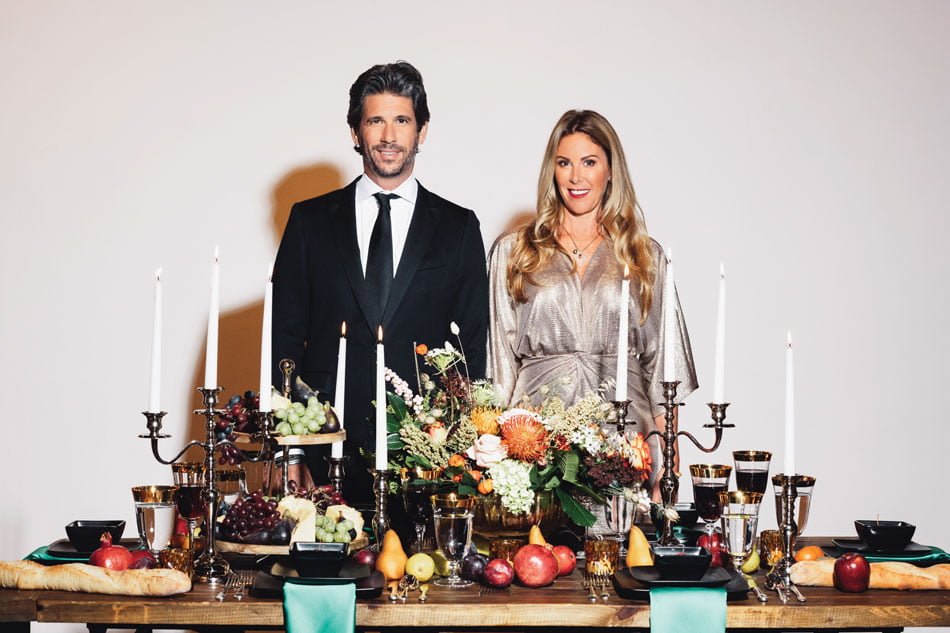By Sebastien & Sheila Centner, Eatertainment Events & Catering
Setting the table, whether it comes to décor or dishes, can be stressful for any host. The more you entertain the better you will get at it, but we always like to help speed up that process by sharing some of the knowledge we’ve accumulated over the past decade or so – both from entertaining ourselves and through our company, Eatertainment Events & Catering.
For this issue of Cayman Marshall Magazine, we are thrilled to be sharing some table-setting basics, along with some of our favourite tips.
To begin with, we always like to set the table properly, whether we are hosting a formal or casual meal for friends, colleagues or family. It almost doesn’t matter what you are serving; even if it’s take-out, a properly set table sets the stage and makes your guests feel special.
Sebastien’s mother Maryvone passed down to us not only her love of entertaining, but also the European tradition of setting a beautiful table for any occasion. Now even our boys always set the table with us, as it’s a great way to spend time together, gives them a sense of pride and ownership over the occasion, and of course it’s a great thing to learn and be able to pass on to the next generation of hosts!
Another important element to setting the table is where to seat each guest. Our sons, Colsen and Logan, are also in charge of the seating plan and deciding who will sit next to whom. The goal is always to encourage conversation and foster new connections, all while keeping in mind to have a familiar face close enough that everyone feels comfortable.

The Perfect Table
A properly set table is the first step to wowing guests with your hosting know-how. But between knowing what cutlery should be used and where, how many and what type of glasses are needed, and all the other elements that come into play, setting the table properly can get overwhelming quickly.
While it’s true there is an art to table setting, it can actually be quite simple once you learn a few basics. We’ve included examples of some of the most popular settings to cover you for most occasions. But before we even get to these, remember some of the foundations of setting the table:
Cutlery
Cutlery should always be placed based on the courses being served, from the outside inwards. No matter the occasion or guest list, if you always start with the outermost cutlery and work your way in, you should be safe.
Dishes
Generally speaking, while the practice of pre-placing dishes at each setting is perfect for starting off the meal, you will invariably need to remove those dishes to plate the food (unless, of course, the meal is served family or buffet style). Keep this in mind as you set the table
to ensure you aren’t trying to wash dishes in between courses.
Glassware
Unless your meal includes swapping from white to red (or vice versa), in which case you might need multiple wine glasses matched to each type of wine you are serving, there is nothing wrong with keeping it simple and using a water glass and a single wine glass for guests to
use, whether they choose white or red wine.
Placecards
Placecards are especially useful when hosting more than four guests. They should be placed in advance, and consider what we mentioned earlier about fostering conversation while also making people comfortable.
Napkins
The first thing people do when they sit down is reach for the napkin. So placing the napkin underneath the forks can create quite a bit of noise and the occasional dropped fork as guests pull out their napkin for use. Placing it on top or underneath the plate can eliminate this awkward moment.
Setting
Breakfast: Large plate, fork and butter knife (a sharper knife likely won’t be needed), spoon for oats or cereal, coffee cup, juice/water glass, side plate.


Lunch: Large plate, salad fork, fork and knife, soup spoon, juice/water glass, side plate.


Dinner: Small starter plate, large dinner plate, salad fork, fork and knife, soup spoon, dessert spoon, juice/water glass, wine glass, side plate with butter knife (for bread).


Brunch: Large plate, small fork for starting items, fork and knife for main, spoon for oats or cereal, coffee cup, juice/water glass, wine or champagne flute for mimosa, side plate.


Formal: Small starter plate, large dinner plate, salad fork, fork and knife, soup spoon, dessert spoon, juice/water glass, red and white wine glasses (typically one is removed once guest decides which they prefer), small side plate with butter knife (for bread), regular side plate.


A few of Seb & Sheila’s Top Personal Tips
Here are a few of our top tips for setting the table.
- If you and your guests are celebrating something special and you plan on making a toast, be sure to include champagne glasses, which should be placed furthest to the right to enable guests to easily raise their glasses.
- Instead of florals, consider using greenery from the garden as a quick way to add a pop of colour or freshness to any table. Layer the greenery under votive holders with floating candles for an inexpensive way to decorate your table.
- Don’t just save formal flatware, stemware or plateware for special occasions – if you’ve got it, use it!
- If you have special items that have sentimental meaning or were passed down from generation to generation, include them and use them as a great conversation starter: “my great-grandmother’s gravy boat ,” or “my mother’s favourite wine glasses.”
- Not everything has to match. Have fun with your table settings, add some whimsical items, or mix and match different patterns for a more eclectic feel.
Don’t Forget to Follow:
@sebandsheila
@sebcentner
@sheilacentner
@eatertainment






